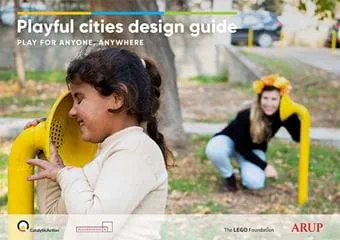The Playful Cities Design Guide is a resource that complements the Playful Cities Toolkit and provides practical and inspirational ideas to help urban practitioners and city authorities to imagine and embed small-scale play elements for children, youths, and adults in city design and planning.
It explores the spatial dimensions of play and how diverse urban spaces can enable play for everyone, anywhere. The publication is a rich compendium of play elements and practical examples that can be adapted and used in different design processes and socio-cultural contexts to trigger and support play as a crucial element of our everyday life.
The Playful Cities Design Guide addresses three questions:
1. Where can we add play in our cities, and what kinds of spatial elements can support playful experiences?
2. How can we design for play that is inclusive of different age groups, abilities, and identities?
3. How can play help us to develop a diverse range of skills, as well as to connect to our urban and natural environment?
Play includes a wide variety of activities which can be unpredictable, spontaneous, irrational, and risky, and which are often unanticipated by urban practitioners, policymakers, and other users. By illustrating the forms that play may take in cities, this Guide reveals people’s creativity, curiosity, imagination, movement, interactions, learning and emotions in using urban space.
For more information on the Playful Cities Design Guide publication, contact Sara Candiracci and Dasha Moschonas
Sorry, it looks like there are no results for
Suggestions
View all results for

